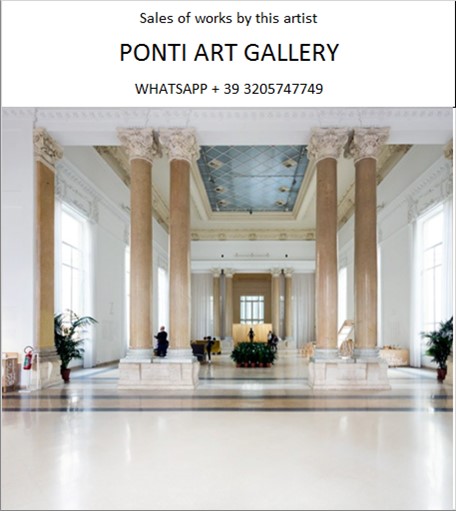Ponti Art Gallery is interested in buying and selling works
of art by this artist.

Conrad Marca-Relli Biography
Conrad Marca-Relli, born Corrado Marcarelli on June 5, 1913, in Boston, Massachusetts, was a pivotal figure in the American Abstract Expressionism movement. His innovative approach to collage and his bridging of the European avant-garde with American abstract expressionism marked him as a significant artist of the 20th century.
Marca-Relli's parents were Italian immigrants, and his early life was marked by frequent travels between the United States and Europe due to his father's career as a journalist and news commentator. This transatlantic upbringing exposed him to a variety of cultural influences and artistic traditions. He took his first art lessons in Italy, which would later inform his work's European sensibilities.
Although largely self-taught, Marca-Relli briefly attended the Cooper Union Institute in New York City in 1930. His formal education was short-lived, but it provided a foundation for his artistic pursuits. By the age of 18, he had established his own studio in New York City, immersing himself in the burgeoning art scene.
During the Great Depression, Marca-Relli found employment with the Works Progress Administration (WPA) Federal Art Project from 1935 to 1938. This experience was crucial as it allowed him to dedicate his time to art and introduced him to a community of progressive artists, including Willem de Kooning, Franz Kline, and John Graham. These connections would prove influential in his development as an artist.
After serving in the army during World War II, Marca-Relli returned to New York and resumed painting. His early work was influenced by the dreamlike imagery of the Surrealists, but he soon made a critical breakthrough with large-scale collage paintings that frequently drew inspiration from the human form. His work from this period was characterized by a Surrealist style influenced by Giorgio de Chirico, Henri Rousseau, and Joan Miró.
In 1947, Marca-Relli moved to Paris and then to Rome, where he became involved with Italian artistic circles. His paintings from this period began to show an increasing abstraction, a trend that would continue throughout his career. By the late 1940s, motivated by the work of Arshile Gorky, Marca-Relli shifted towards thickly painted abstract forms.
Marca-Relli's experiments with collage began in 1953 when he ran out of paint while traveling in Mexico. He began cutting strips of canvas and affixing them to his paintings, a technique that allowed him to capture the texture of the adobe buildings he observed. This method of working with canvas and raw linen collage elements became a hallmark of his style, allowing him to achieve a sense of depth without sacrificing the unity between background and foreground.
His large-scale collages were revolutionary, raising the art form to a level of complexity and scale comparable to monumental painting. This innovation paved the way for the large "combine paintings" of the Neo-Dada artists of the 1960s. Marca-Relli's work was characterized by a constructive approach to image-making, building up surfaces by applying shapes to canvas or metal supports. He sought controlled, complex compositions of interlocking forms rather than gestural movement or uncontrolled spontaneity.
Throughout his career, Marca-Relli maintained strong ties to Europe, living and working in various European capitals, including France, Spain, and Italy. He looked to European painters from the Renaissance, Cubism, and metaphysical movements for inspiration. His regular journeys to Europe formed an important bridge between art circles on both sides of the Atlantic.
Marca-Relli's nomadic lifestyle and his commitment to exploring new materials and techniques kept him at the forefront of the art world. He experimented with wood, aluminum, and vinyl in his assemblage 'paintings,' which led to carefully structured compositions. His work entered the collections of major museums, including the Guggenheim Museum, the Metropolitan Museum of Art, the Museum of Modern Art, and the Whitney Museum of American Art.
In his later years, Marca-Relli lived in Parma, Italy, with his wife, Anita Gibson, whom he married in 1951. He continued to paint until his death on August 29, 2000. His legacy is celebrated for the richness and variation of his uniquely constructed images and his significant contribution to the Abstract Expressionist movement. Conrad Marca-Relli's work remains a testament to his innovative spirit and his ability to synthesize diverse artistic influences into a coherent and powerful body of work.
Conrad Marca-Relli Quotes and
Sales of Works
Ponti Art Gallery selects and deals with paintings by the
artist. Upon request, we provide free estimates and
evaluations, communicate prices, quotations, and current
market values.
If you are interested in BUYING or SELLING works by the
artist, contact us immediately.
If you wish to sell or receive an evaluation of the
works:
Send us a frontal photo of the painting, one of the back,
and one of the signature. Also, indicate the dimensions of
the work. Inform us about the purchase origin of the work
and any kind of available documentation (purchase
receipts, certificates of authenticity, publications). One
of our operators will respond to you on the same day. We
guarantee maximum confidentiality and extreme
professionalism.
If you wish to purchase works by the painter: Contact us
and let us know your request. We will inform you about the
available works. We also offer the possibility to
subscribe to our NEWSLETTER, through which you will be
informed at the beginning of each month about the latest
acquisitions of the art gallery.
You can send us pictures of the work:
